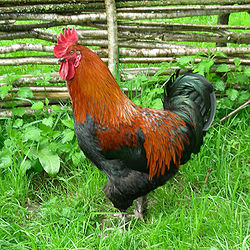- Marans
-
For other uses, see Marans (disambiguation).
Marans 
Young Lakenvelder hens (in foreground)Other names Poule de Marans Country of origin France Classification Traits Egg Color dark brown Chicken (Gallus gallus domesticus) The Marans is a breed of chicken originating in France. It is a medium breed compared to others, popular for poultry shows and is a dual purpose fowl known both for its extremely dark eggs as well as for its very fine meat qualities.
Contents
Appearance
There are 9 recognized colors in the French Standard: Cuckoo, Golden Cuckoo, Black, Birchen, Black Copper, Wheaton, Black-tailed Buff, White and Columbian; other colours not officially recognized (such as Blue Copper) also exist. Black Copper (black with copper feathers on the neck) and Cuckoo (barred feathers, giving a black and white speckled appearance) are the most common of these.
The breed as it was when first brought to England was very variable in appearance. The only colours at this time were the white and brassy black. The breed became more of a standard breed than a country fowl due to the vigorous breeding standards of early British breeders, however this was only started fairly early in the 20th century, To the present day there is still much work to be done as "throw backs" are prevalent in the form of white and black birds being bred from other coloured strains. Sporadically appearing yellow colouration to the legs and beak rather than the preferred white is also a problem found in the breed.
All have red or orange eyes and white feet. They are in the medium weight class, generally rather smaller than the more common Rhode Island Red.
The original Marans have feathered legs but this has been bred out by many UK breeders.
Characteristics
Marans are generally quiet and docile; but they are quite active, taking well to free ranging in rough terrain and are also tough and disease-resistant. They were originally bred in the marshy areas of France and can cope with damper conditions.
Marans lay around 150 dark brown eggs each year. Marans are an historically dual-purpose bird, prized not only for their dark eggs but for their table qualities as well.
History
The Marans originate from France, and were imported into the United Kingdom in the 1930s.
During 1929, Lord Greenway was attracted by the particular fleshing qualities of the Marans he saw at the Paris exhibition. (The birds having a fine textured white flesh with gourmet flavour, and at the time fast growing) Unfortunately at that time there was an import restriction on livestock, but some eggs were smuggled into the county that same year in a luncheon basket as hard-boiled eggs.
J S Parkin, Lord Greenway’s Poultry Manager hatched stock from these eggs and found the brown egg factor – he was so impressed that as soon as the restrictions were lifted he imported 60 day old chicks. These early birds had both Silver or Dark Cuckoo markings and feathered shanks. Black, Cuckoo, & White birds were derived from these birds. Lord Greenway first showed Marans at Crystal Palace in 1934. They were subsequently shown at the World Poultry Congress in Rome & London.
In England there was difficulty differentiating between the Cuckoo Marans and other Continental Cuckoo breeds, especially the North Holland Blue unless the eggs could be seen, so after some years he concentrated his efforts on the selection of the Cuckoo variety exclusively. At that time both clean & feathered shanks were common and he decided to breed clean shanked birds. Due to the instability of the plumage of this variety, he subdivided it into two sub-varieties: Dark Cuckoo and Silver Cuckoo. These English Marans were developed with clean shanks, as breeders had difficulty differentiating them from other feathered shanked European breeds that laid cream/tinted eggs, some Barred Plymouth Rock & Light Sussex being used in their makeup. Interestingly whilst breeding out the shank feathers of Marans the British breeders bred them on to the clean shanked North Holland Blues.
Marans were accepted into the British Standard in 1935, the Standard having been drawn up by J S Parkin and W Powell-Green, Gold Cuckoos followed in 1944, together with the Blacks in 1952, unfortunately the Whites died out. Black Copper-necks were also imported from France in the 1930s but were never accepted into the British Standard. The popularity for the dark egg lead to indiscriminate breeding over the next 20 years to try and improve the identification of pullets and cockerels as day old. Good pure Marans can be devilishly difficult to sex when young - and the cockerels eat a lot.
Day old sexing meant the breeders didn't have to rear the cockerels so they could rear more pullets at reduced costs. This was done by using other breeds such as the Light Sussex - their offspring were then put to a pure Marans and the resulting Marans-looking young were sold as Marans. The cockerels were much lighter at day old so it was easier to cull them out. Successive years of breeding from these stocks produced a paler egg, poorer productivity and more white in the feathering (from the Light Sussex).
Good pure Marans are now very difficult to find as a result, as it can be very difficult to distinguish between these birds and the mongrelised version which has become incorporated into some stocks.
Recent importations from France into the UK have resulted in both clean shanked and feathered shanked birds being available. The Poultry Club of Great Britain currently refuses to recognise the feathered birds, though they are accepted by The Marans Club of Great Britain.[1]
References
- Raymond, Francine (2001). The Big Book of Garden Hens. Kitchen Garden Books, ISBN 0-9532857-3-1
2 The Marans Club of Great Britain http://www.themaransclub.co.uk
Categories:- Chicken breeds
Wikimedia Foundation. 2010.


